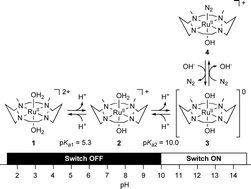Dissolved N2 sensing by pH-dependent Ru complexes†
Abstract
This paper describes the synthesis and characterisation of

* Corresponding authors
a
Applied Chemistry, Graduate School of Engineering, Kyushu University, 744 Moto-oka, Nishi-ku, Fukuoka, Japan
E-mail:
ogotcm@mail.cstm.kyushu-u.ac.jp
Fax: 81 92 802 3307
Tel: 81 92 802 2818
b Core Research for Evolutional Science and Technology (CREST), Japan Science and Technology Agency (JST), Kawaguchi Center Building, 4-1-8 Honcho, Kawaguchi-shi, Saitama, Japan
This paper describes the synthesis and characterisation of

 Please wait while we load your content...
Something went wrong. Try again?
Please wait while we load your content...
Something went wrong. Try again?
T. Kizaki, T. Matsumoto and S. Ogo, Dalton Trans., 2010, 39, 1339 DOI: 10.1039/B918940H
To request permission to reproduce material from this article, please go to the Copyright Clearance Center request page.
If you are an author contributing to an RSC publication, you do not need to request permission provided correct acknowledgement is given.
If you are the author of this article, you do not need to request permission to reproduce figures and diagrams provided correct acknowledgement is given. If you want to reproduce the whole article in a third-party publication (excluding your thesis/dissertation for which permission is not required) please go to the Copyright Clearance Center request page.
Read more about how to correctly acknowledge RSC content.
 Fetching data from CrossRef.
Fetching data from CrossRef.
This may take some time to load.
Loading related content
